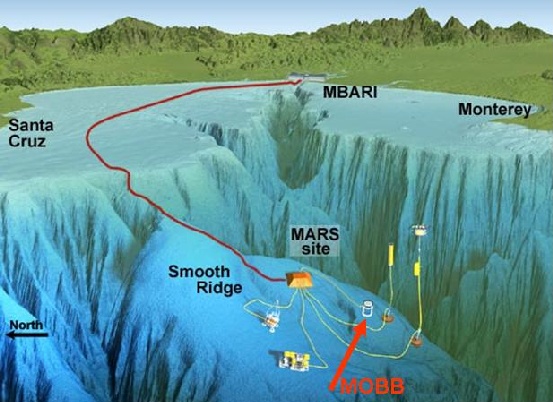Seismo Blog
An Umbilical From The Abyss
Categories: California | Instrumentation | Ocean Bottom Seismometer | MOBB
March 10, 2009
Cannery Row, John Steinbeck, the Aquarium - they all seen synonymous with Monterey. Particularly the Monterey Bay Aquarium, with its dazzling and sometimes dizzying display of sea creatures, is an attraction for locals and tourists alike. The avid blog reader may ask, what does this advertising pitch for the aquarium have to do with seismology. The answer can be found in a sprawling laboratory building a few miles north of Cannery Row in Moss Landing. This is where a sister institution of the aquarium has its home, the Monterey Bay Aquarium Research Institute (MBARI). Without the work and support of their dedicated people, the seismic station MOBB (see two previous blog entries) probably would not exist.

|
|
|
Figure 1: A 3-D map of the Mars project (image courtesy of MBARI)
|
Founded in 1987, MBARI does much more than biological research in support of the aquarium. Several of their researchers are interested in marine geology, particularly in seismology. This led to a cooperation with BSL on placing seismometers on the ocean floor. The most recent result of the joint effort was the deployment of MOBB on the sea floor in April 2002 by the undersea robot "Ventana." This remotely operated vehicle is part of MBARI’s research fleet. It is carried out to sea by its mothership, "R/V Point Lobos." From a control room in the bow of the ship, a pilot operates the Ventana using a joystick and computer controls.
In the years following the deployment, Ventana regularly returned to MOBB every few months, supplied it with new batteries and collected its data. The recordings were then shipped to BSL and - ex post facto - integrated into our data base.
But MBARI folks had much bigger plans for MOBB. They wanted it to become part of a large ensemble of scientific sensors on the seafloor. These sensors were to be permanently linked to land by a cable, which would provide power and a high speed data link. This idea led to MARS, not the planet, but the Monterey Accelerated Research System. Its heart is a node resting on the seafloor some 23 miles off the coast of Moss Landing. It was installed last November and allows eight different sensors to be connected to it - and hence their data to become available in real-time to researchers on land. The first instrument connected was a sonde which measures the salinity, temperature and pressure of the ocean water. MOBB was added late last month. For what is still to come on the slope of submarine Monterey Canyon, visit the MARS website.(hra033)
BSL Blogging Team: Who we are
Recent Posts
-
: Alerts for the Whole West Coast
-
: Destruction in the Eastern Aegean Sea
-
: An Explosion in Beirut heard all over the Middle East
View Posts By Location
Categories
- Alaska (3)
- Bay Area (24)
- Buildings (3)
- Calaveras (4)
- California (13)
- Central California (4)
- Chile (4)
- Earthquake Early Warning (10)
- Earthquake Faults and Faulting (44)
- Earthquake Science (3)
- Haiti (3)
- Hayward (12)
- Indonesia (4)
- Induced Seismicity (3)
- Instrumentation (18)
- Italy (6)
- Japan (7)
- MOBB (3)
- Mendocino Triple Junction (5)
- Mexico (7)
- Nepal (3)
- North Korea (5)
- Nuclear Test (5)
- Ocean Bottom Seismometer (3)
- Oklahoma (4)
- Plate Tectonics (18)
- Preparedness, Risks, and Hazards (15)
- Salton Sea (3)
- San Andreas Fault (14)
- Seismic Waves (13)
- Seismograms (4)
- ShakeAlert (3)
- Southern California (5)
- Surface Waves (3)
- Today in Earthquake History (20)
- Volcanoes (4)
- subduction (3)